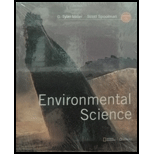
The way in which the human population has surpassed 7.4 billion. The three factors that have led to a rapid increase in human population over the past 200 years.
Answer to Problem 1CR
The population on the earth was 2 billion about 200,000 years ago. The exponential increase in population growth rate caused an increase in the world population to 7.4 billion. The three factors that are responsible for the increase in population are the development of agriculture, technology, and medicine. These factors have decreased the death rate and increased the overall population.
Explanation of Solution
About 200,000 years ago, the estimated population of a human being was 2 billion. After 50 years, the population of a human being on the Earth became double. In 1974, the population on the earth was around 4 billion, and in the next 25 years, the population increased to 7.4 billion.
The three most populated countries of the world include China (1.38 billion, India (0.33 billion) and the United State (324 billion) people. In case, the population keeps increasing by this rate, the population of the world would be 9 billion in 2050. According to scientists, the exponential growth of human population is unsustainable on the earth. The increasing population would utilize more natural resource which would lead to a deficiency of resource and life would become difficult.
Three factors that cause an increase in population on the Earth are explained as follows:
(i) Agriculture emerged about 10,000 years ago. The development of agriculture increased food production on earth. It increased the survival of the human population.
(ii) Development of technologies helped the human being to examine the weather conditions. There are various technologies which provide information about earthquakes and tsunamis. Human beings are capable of reducing the extent of damage caused by natural disasters. It also increases the survival of people and lowers the death rate.
(iii) The development of hospitals and medicines also decreased the death rate. There are a lot of antibiotics and vaccines that can prevent infectious disease. It improves the health of people that increase the survival of people, and the death rate is decreased.
Want to see more full solutions like this?
Chapter 6 Solutions
ENVIRONMENTAL SCIENCE (HIGH SCHOOL)
- Please answer all parts of the question and show all workarrow_forward1. The field of hydrogeology includes: a. soil water movement b. rainfall runoff and flood generation c. placement of water wells to optimize the quantity and quality of water supplies d. all of the above e. a and c 2. Groundwater occurrence and movement has no direct influence on: a. earthquake activity b. land subsidence c. land slide potential d. hydraulic conductivity e. soil formation f. none of the above 3. In terms of Earth's water budget, groundwater ranks a. higher b. lower 4. Ultimately, the hydrological cycle is driven by: a. geothermal energy fluxes toward Earth's surface b. orographic rainfall due to abrupt changes in elevation c. solar energy fluxes toward Earth's surface d. adiabatic cooling in the atmosphere 5. In the equation below, the variable "Var" refers to: a. void ratio b. pressure head c. hydraulic conductivity d. intrinsic permeability than glaciers and ice caps: P Var = p.garrow_forwardDeep water- waves with constant wavelength Wave movement Approaching shore- waves touch bottom (wavelength decreases) Surf zone (breakers form) Waves touch bottom as they encounter water depths that are less than half a wavelength C E B 00000 00000 Depth is >½ wavelength 0000 0000 Velocity decreases (wave height increases)arrow_forward
- Activity 12.1: Wave Characteristics Pg 200 1. Refer to Figure 12.1 and select the letter that identifies each of the following.wave crestwave troughwavelengthwave heightwave base 2. Below what depth would a submarine have to submerge so that it would not be swayed by surface waves with a wavelength of 24 meters?____ mActivity 12.2: Deep Versus Shallow Water Waves Pgs 201-202Refer to Figure 12.1 to answer the following questions. 1. Do particles in deep-water waves trace out circular or elliptical paths? 2. Near the shore in shallow water, do water particles trace out circular or elliptical 3. In shallow water, are water particles in the wave crest ahead of or behind those at the bottom of the wave? 4. As waves approach the shore, do their heights increase or decrease? Do wavelengths become longer or shorter? 5. In the surf zone, is the water in the crest of a wave falling forward or standing still? 6. What is the velocity of deep-water waves that have a wavelength of 46 meters and a…arrow_forwardSubject: Hydrogeology Please answer the question correctly and in detail and show all workarrow_forwardSubject: Hydrogeology Please answer both parts of the question correctly and in detail and show all workarrow_forward
 Applications and Investigations in Earth Science ...Earth ScienceISBN:9780134746241Author:Edward J. Tarbuck, Frederick K. Lutgens, Dennis G. TasaPublisher:PEARSON
Applications and Investigations in Earth Science ...Earth ScienceISBN:9780134746241Author:Edward J. Tarbuck, Frederick K. Lutgens, Dennis G. TasaPublisher:PEARSON Exercises for Weather & Climate (9th Edition)Earth ScienceISBN:9780134041360Author:Greg CarbonePublisher:PEARSON
Exercises for Weather & Climate (9th Edition)Earth ScienceISBN:9780134041360Author:Greg CarbonePublisher:PEARSON Environmental ScienceEarth ScienceISBN:9781260153125Author:William P Cunningham Prof., Mary Ann Cunningham ProfessorPublisher:McGraw-Hill Education
Environmental ScienceEarth ScienceISBN:9781260153125Author:William P Cunningham Prof., Mary Ann Cunningham ProfessorPublisher:McGraw-Hill Education Earth Science (15th Edition)Earth ScienceISBN:9780134543536Author:Edward J. Tarbuck, Frederick K. Lutgens, Dennis G. TasaPublisher:PEARSON
Earth Science (15th Edition)Earth ScienceISBN:9780134543536Author:Edward J. Tarbuck, Frederick K. Lutgens, Dennis G. TasaPublisher:PEARSON Environmental Science (MindTap Course List)Earth ScienceISBN:9781337569613Author:G. Tyler Miller, Scott SpoolmanPublisher:Cengage Learning
Environmental Science (MindTap Course List)Earth ScienceISBN:9781337569613Author:G. Tyler Miller, Scott SpoolmanPublisher:Cengage Learning Physical GeologyEarth ScienceISBN:9781259916823Author:Plummer, Charles C., CARLSON, Diane H., Hammersley, LisaPublisher:Mcgraw-hill Education,
Physical GeologyEarth ScienceISBN:9781259916823Author:Plummer, Charles C., CARLSON, Diane H., Hammersley, LisaPublisher:Mcgraw-hill Education,





